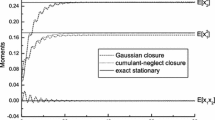Abstract
A data-driven method is established to derive the (approximately) analytical expression of the stationary response probability density of nonlinear random vibrating system, which explicitly includes system features and intensity of excitation. The stationary response probability density is first assumed as an exponential form by using the principle of maximum entropy. Through the rule of dimensional consistency, the power of exponential function is expressed as a linear combination of a set of nondimensional parameter clusters which are constituted by system features, intensity of excitation, and state variables. By comparing the power of exponential function with the approximate logarithm probability density evaluated from simulated data statistically, the determination of unknown coefficients comes down to the solution of (overdetermined) simultaneous linear algebraic equations. The data-driven method rediscovers the exact stationary response probability density of random-excited Duffing oscillator and derives an approximately analytical expression of stationary response probability density of van der Pol system from the simulated data of six cases with different values of system features and intensity of excitation. This data-driven method is a unique method which can explicitly include the information of system and excitation in the analytical expression of stationary response probability density. It avoids the solution of simultaneous nonlinear algebraic equations encountered in the maximum entropy method and closure methods and, in the meanwhile, avoids the sophisticated selection of weighting functions in closure methods.













Similar content being viewed by others
References
Lutes, L.D., Sarkani, S.: Random Vibrations: Analysis of Structural and Mechanical Systems. Elsevier, Butterworth-Heinemann (2004)
Sobczyk, K.: Stochastic dynamics of engineering systems: origins, challenges and results. In: Gutkowski, W., Kowalewski, T.A. (eds.) Mechanics of the 21st Century, pp. 19–60. Springer, Netherlands (2005)
Lin, Y.K., Cai, G.Q.: Probabilistic Structural Dynamics: Advanced Theory and Application. McGraw-Hill, New York (1995)
Zhu, W.Q., Cai, G.Q.: Elements of Stochastic Dynamics. World Scientific, Hackensack (2017)
Ibrahim, R.A.: Nonlinear random vibration: experimental results. Appl. Mech. Rev. 44(10), 423–446 (1991)
Pradlwarter, H.J., Schueller, G.I.: On advanced Monte Carlo simulation procedures in stochastic structural dynamics. Int. J. Nonlinear Mech. 32(4), 735–744 (1997)
Sobczyk, K., Trebicki, J.: Maximum entropy principle and nonlinear stochastic oscillators. Phys. A 193, 448–468 (1993)
Ricciardi, G., Elishakoff, I.: A novel local stochastic linearization method via two extremum entropy principles. Int. J. Nonlinear Mech. 37, 785–800 (2002)
Sobczyk, K., Trebicki, J.: Approximate probability distributions for stochastic systems: maximum entropy method. Comput. Methods Appl. Mech. Eng. 168, 91–111 (1999)
Yong, Y., Lin, Y.K.: Exact stationary-response solution for second order nonlinear systems under parametric and external white-noise excitations. ASME J. Appl. Mech. 54(2), 414–418 (1987)
Langtangen, H.P.: A general numerical solution method for Fokker-Planck equations with applications to structural reliability. Prob. Eng. Mech. 6(1), 33–48 (1991)
Bergman, L.A., Masud, A.: Application of multi-scale finite element methods to the solution of the Fokker–Planck equation. Comput. Methods Appl. Mech. Eng. 194, 1513–1526 (2005)
Sun, J.Q., Hsu, C.S.: The generalized cell mapping method in nonlinear random vibration based upon short-time Gaussian approximation. ASME J. Appl. Mech. 57(4), 1018–1025 (1990)
Tombuyses, B., Aldemir, T.: Continuous cell-to-cell mapping. J. Sound Vib. 202(3), 395–415 (1997)
Iourtchenko, D.V., Mo, E., Naess, A.: Response probability density functions of strongly nonlinear systems by the path integration method. Int. J. Nonlinear Mech. 41, 693–705 (2006)
Kougioumtzoglou, I.A., Di Matteo, A., Spanos, P.D., Pirrotta, A., Di Paola, M.: An efficient Wiener path integral technique formulation for stochastic response determination of nonlinear MDOF systems. ASME J. Appl. Mech. 82(10), 101005 (2015)
Psaros, A.F., Kougioumtzoglou, I.A., Petromichelakis, I.: Sparse representations and compressive sampling for enhancing the computational efficiency of the Wiener path integral technique. Mech. Syst. Signal Process. 111, 87–101 (2018)
Saha, N., Roy, D.: The Girsanov linearization method for stochastically driven nonlinear oscillators. ASME J. Appl. Mech. 74(5), 885–897 (2007)
Ibrahim, R.A.: Parametric Random Vibration. Research Studies Press, Letchworth (1985)
Assaf, S.A., Zirkie, L.D.: Approximate analysis of nonlinear stochastic systems. Int. J. Control 23, 477–492 (1976)
Er, G.K.: Exponential closure method for some randomly excited non-linear systems. Int. J. Nonlinear Mech. 35, 69–78 (2000)
Er, G.K.: Methodology for the solutions of some reduced Fokker-Planck equations in high dimensions. Ann. Phys. 523(3), 247–258 (2011)
Er, G.K.: Probabilistic solutions of some multi-degree-of-freedom nonlinear stochastic dynamical systems excited by filtered Gaussian white noise. Comput. Phys. Commun. 185, 1217–1222 (2014)
Di Paola, M., Sofi, A.: Approximated solution of the Fokker–Planck–Kolmogorov equation. Probab. Eng. Mech. 17, 369–384 (2002)
Chen, L.C., Liu, J., Sun, J.Q.: Stationary response probability distribution of SDOF nonlinear stochastic systems. ASME J. Appl. Mech. 84, 051116 (2017)
Martens, W., von Wagner, U., Mehrmann, V.: Calculation of high-dimensional probability density functions of stochastically excited nonlinear mechanical systems. Nonlinear Dyn. 67, 2089–2099 (2012)
Bridgeman, P.W.: Dimensional Analysis. Yale University Press, New Haven (1963)
Zhang, S., Lin, G.: Robust data-driven discovery of governing physical laws with error bars. Proc. R. Soc. A 474, 20180305 (2018)
Huang, Z.L., Tian, Y.P., Li, C.J., Lin, G., Wu, L.L., Wang, Y., Jiang, H.Q.: Data-driven automated discovery of variational laws hidden in physical systems. J. Mech. Phys. Solids 137, 103871 (2020)
Lucero, J.C., Schoentgen, J.: Modeling vocal fold asymmetries with coupled van der Pol oscillators. Proc. Meet. Acoust. 19, 060165 (2013)
Funding
This study was supported by the National Natural Science Foundation of China under Grant Nos. 11872328, 11532011, 11972317, and 11621062 and the Fundamental Research Funds for the Central Universities under Grant No. 2018FZA4025.
Author information
Authors and Affiliations
Corresponding author
Ethics declarations
Conflict of interest
The authors declare that they have no conflict of interest.
Additional information
Publisher's Note
Springer Nature remains neutral with regard to jurisdictional claims in published maps and institutional affiliations.
Rights and permissions
About this article
Cite this article
Tian, Y., Wang, Y., Jiang, H. et al. Stationary response probability density of nonlinear random vibrating systems: a data-driven method. Nonlinear Dyn 100, 2337–2352 (2020). https://doi.org/10.1007/s11071-020-05632-4
Received:
Accepted:
Published:
Issue Date:
DOI: https://doi.org/10.1007/s11071-020-05632-4




